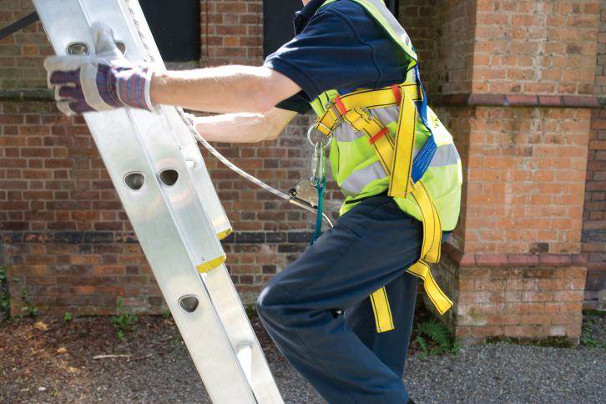Evolution of safe working at height from ladders processes and training

I well remember how unsafe the field service consumer electronics / signal reception and installation industries used to be; the ethos from many organisations back in the day was "Work safely!" whilst equipping you with a mains powered hammer drill and mains extension (with no RCD or ELCB) to work outside in the pouring rain. If any questions were asked, then the common response was that you should also use a plastic bag to cover the drill so that it didn't get wet! PPE was just another TLA (three letter acronym) that didn't mean a great deal to most installers or organisations and basically anything was possible; installers gracefully skipping over the wet roof tiles in plimsolls whilst being battered by gale force winds and pummelled by hailstones the size of golf balls - ok maybe a little exaggeration there but you all have your own stories I'm sure!
The good old days - NOT!
Things have certainly changed over the last twenty years and none more so in the area of working safely at height from ladders and on roofs. I have encountered some people that think that it has gone too far, being overly restrictive, but so long as the domestic antenna signal reception sector is lumped into the construction industry, then a belts and braces approach is here to stay and needs to be embraced by all and has taken significant time and much pain (no pun intended) to get to the stage where we are now - with the best training and safest working processes ever to reduce the risk of injury for all installation engineers; self-employed or those working for an organisation.

BSkyB (amongst other major organisations) started the ball rolling on scale in the early 2000s in an attempt to ensure the safe lone working of its installation staff - over 1500 people in the ramp between analogue switch off and digital switchover. Introducing WAH training and basic standard equipment including; ladder stabilisation, battery powered hammer drills and basic PPE such as hard hat and working boots, was a very formative step forward that provided a no-nonsense, common sense approach and was the "big bang" of safe working practices on scale enabling them to evolve further and to be replicated and enhanced by other organisations.
This introduction also had significant implications economically and culturally for organisations with the welfare of installation staff now better balanced alongside profitability and scaled up, volume based installations. We must also remember though that an another important factor that necessitated the introduction of safe working practices was (and still is), to protect the organisation and its directors from the threat of corporate manslaughter through their negligence; this is a significant fear for the directors of any organisations that have many thousands of people as indirect reports, and especially those working on their own in potentially hazardous environments.
These processes evolved further in the last decade and high quality, independent WAH training and consultancy organisations emerged adding significant contribution to the evolution of the safe working processes. Alongside all of this, the Confederation of Aerial Industries reinforced the safe working procedures as their approved working processes for CAI members which enabled hundreds of independent installers and smaller organisations to "join the party" so to speak.
By the mid 2000s, the safe working processes evolved to include many other components; eyebolts to secure the ladders via straps, fall protection equipment including personal harness and rope systems, safe chimney and roof working systems and enhanced PPE including dust mask, ear and eye protection and knee protection. What was previously a single day, presentation based training programme had now extended to, in some cases, a two or three day programme including competency based instruction, replication and assessment and formed an essential and significant developmental part of the induction period for new starters coming into the industry.
All of the good work previously done by industry stakeholders proved its worth when it came to the Digital Switchover Programme phased launching in 2008 in the UK. One of the requirements from the BBC for any installer to complete DSO work was to be RDI Pink Tick approved and this meant that an RDI member must have completed an accredited and certificated WAH competency based training course and this encouraged independent training providers to support DSO with high quality, cost effective competency based training to enable DSO installers to work safely. Although there is no legislation as yet to indicate formally how often this type of training requires a refresher, the CAI, RDI and associated training providers wisely gave their expectations as a guideline and requirements for members and installers; between three and five years has been indicated as a typical period between which a WAH refresher is recommended.
Within a large organisation, initial and refresher training is normally part of the operating processes with a management responsibility to ensure that this is effectively completed. For a very small organisation and for a sole trader, then things aren't as clear but one thing is certain; each individual has their own responsibility to ensure that they have the knowledge, skills, processes and equipment to work safely and to gain high quality, effective and relevant training.
With the completion of DSO, there are fewer competency based training providers supporting the industry and this has made it challenging for many installers to find a cost effective, high quality WAH refresher solution; especially for those in more remote and outlying areas. Competency based refresher training is a preferred pathway but with elearning now providing a very effective solution for knowledge based learning, it seems quite natural that this is an area that can support WAH refresher training and indeed it does, but it is the responsibility of the individual learner to ensure that the elearning course is relevant and fulfils the learning requirements for each individual. With this in mind, the Registered Digital Institute has developed an elearning course which fulfils the requirement for a WAH refresher for RDI members and is called "Working Safely from Ladders and in the Customer's Home". This course covers working safely at height from ladders and many other safe working topics including; Risk Assessment, COSHH, PPE, Manual Handling and Electrical Safety. For more information, please go to Working at Heights Refresher - RDI Institute or alternatively email training@rdi-online.co.uk
6:53 PM
I recalled on reading the above article an incident from 40 years ago.A friend requested me to tighten up all fittings on his rooftop aerials BBC NI and HTV Wales 405 as stormy weather had been forecast.This was in Dec 1973.I placed my wooden ladder against the gutter and climbed up to roof of 2 storey house roof sloping at 45 degrees.I tighted all bolts on holding brackets and prepared to come down this was nightime and nobody was around.I discovered that ladder had been blown sideways and had caught on a bracket holding the gutter in place.I sat down on the roof and slowly moved forward to ladder until I could reach it with my foot and suceeded in straighening it up.I then climbed down.A close call but I learned a lesson.
| link to this comment |
7:08 PM
On a few occasions when I was asked to install aerials for tv reception female partner insisted that her partner ewould help in porder to save cost of hiring helper.This resulted in a situation where volunteered help froze on the roof and had to be helped down with additional experienced helpers.I once was climbing up a wooden ladder when a rotten rung broke and I had to hold on to sides of ladder and gradually descend carefully.I was coming down off a garage another time and I put extension ladder upside down on ground,I fell 3 metres and landed sideways.I got a few bad bruises which put me out of action for a few days.One day in Millenium year,after doing a routine job,time caught up with me.I had to make 5 attempts to go off roof onto ladder.i became aware of height and danger.Lesson learned.I did some installations on walls after that always looking over my shoulder in case Health and Safety people were out and about.
| link to this comment |
safety measures in are trade and many others boils down to common sense and if the rigger hasn't got any of that they certainly wouldn't be working for me.
Most of the riggers that I have got to know over the years have always secured ladders where required but not necessarily with eye bolts but tied to the roof batten.
In certain circumstances the use of roof ladders can actually be more of a danger than pushing up tiles and walking up the battens.
It all boils down to individual jobs and the buildings your working on.
The hard hat which has to be worn on sites is understandable but when actually on the roof above everyone else, What is its purpose apart from bird pooh.
Safety boots or commonly known as rigger boots which again is insisted on site work are great when working on clay tiles but no good on slate, where as trainers are the safest option.
Finally and most importantly, If a job in your opinion cannot be done reasonable safe which means you don't feel at ease with the job then you have the option and really should walk away.
Personally I think its only a matter of time before all rooftop ladder work will be outlawed because there is no such thing as safety working at heights where ladders and getting on roofs are concerned, You can be careful as you like taking all safety measures into account but its still very dangerous work , and that is why taking adequate safety measures is still a very grey and shaded area .
Regards
| link to this comment |
